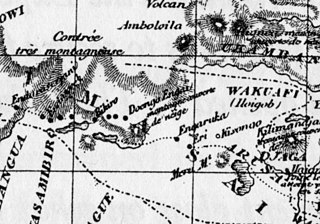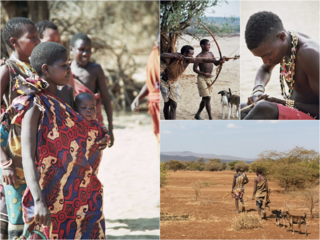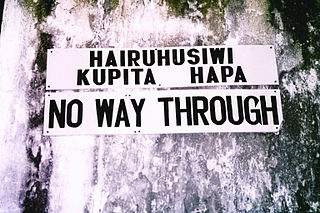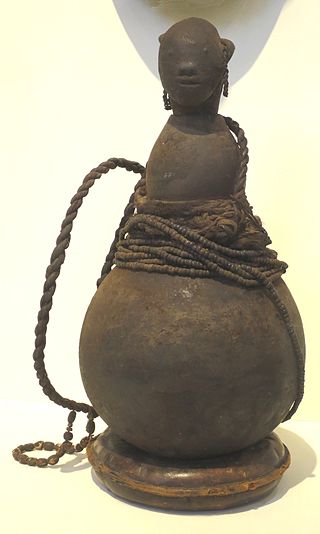Notes
- ↑ Gorowa at Ethnologue (27th ed., 2024)

- ↑ Harvey, Andrew (2019). "Gorwaa (Tanzania) -- language contexts". Language Documentation and Description. 16: 127–168.
| Gorowa | |
|---|---|
| Gorwaa | |
| Native to | Tanzania |
| Region | Dodoma, Manyara |
| Ethnicity | Gorowa |
Native speakers | 110,000 (2009) [1] |
| Language codes | |
| ISO 639-3 | gow |
| Glottolog | goro1270 |
Gorowa is a Cushitic language spoken in Tanzania in the Dodoma and Manyara Regions.
It is also known as Fiome, Goroa, Gorwaa, Kimbulu, Ufiomi. [2]
As of 2014, an estimated 79,000 people (approx. 60% of the ethnic population) use this language on a daily basis. Older Gorwaa speakers in rural areas tend to be enthusiastic about their language and have contributed to a large body of data including songs, traditional stories, uncommon vocabulary, etc. Younger Gorwaa in urban areas view the language as less useful and may be reticent to speak it. Some use the exonym Mbulu (from a large Iraqw settlement) and say they speak Kimbulu; however, this is still the Gorwaa language. Codeswitching with Swahili is ubiquitous. Young speakers involved in documentation of Gorwaa have become researchers and assumed ownership of the project.
Instances of Gorwaa writing are rare, and show a great variety of non-standard spellings. It is common to use the orthography of Iraqw for Gorwaa written communication.
Ogiek is a Southern Nilotic language of the Kalenjin family spoken or once spoken by the Ogiek peoples, scattered groups of hunter-gatherers in Southern Kenya and Northern Tanzania. Most Ogiek speakers have assimilated to cultures of surrounding peoples: the Akie in northern Tanzania now speak Maasai and the Ogiek of Kinare, Kenya now speak Gikuyu. Ndorobo is a term considered derogatory, occasionally used to refer to various groups of hunter-gatherers in this area, including the Ogiek.
The South Cushitic or Rift languages of Tanzania are a branch of the Cushitic languages. The most numerous is Iraqw, with half a million speakers. Scholars believe that these languages were spoken by Southern Cushitic agro-pastoralists from Ethiopia, who began migrating southward into the Great Rift Valley in the third millennium BC.
The Asa (Aasá) language, commonly rendered Aasax, was spoken by the Asa people of Tanzania. The language is extinct; ethnic Assa in northern Tanzania remember only a few words they overheard their elders use, and none ever used it themselves. Little is known of the language; what is recorded was probably Aasa lexical words used in a register of Maasai, similar to the mixed language Mbugu.

Engaruka is an abandoned system of ruins located in northwest Monduli District in central Arusha Region. The site is in geographical range of the Great Rift Valley of northern Tanzania. Situated in the Monduli District, it is famed for its irrigation and cultivation structures. It is considered one of the most important Iron Age archaeological sites in Tanzania. The site is located in the ward of Engaruka. The site is registered as one of the National Historic Sites of Tanzania.
The Kw'adza, also known as the Qwadza, were an ethnic group and Iraqw Communities based in the Mbulu District of Manyara Region, Tanzania. They spoke the Kw'adza language as a mother tongue, which belongs to the South Cushitic branch of the Afro-Asiatic family. The Kw'adza were related to but distinct from the Iraqw. In 1999, Ethnologue reported that the Kw'adza language had become extinct, though no information was given regarding whether living descendants of the Kw'adza people identify themselves as such.

The Iraqw People are the Cushitic-speaking ethnic group inhabiting the northern Tanzanian regions. They are an abundant significant group in originating in southwestern Arusha and Manyara regions of Tanzania, near the Rift Valley. The Iraqw people settled in the southeast of Ngorongoro Crater in northern Karatu District, Arusha Region, where they remain the majority ethnic group. In Manyara region, the Iraqw are a major ethnic group in Mbulu District, Babati District and Hanang District.

The Hadza, or Hadzabe, are a protected hunter-gatherer Tanzanian indigenous ethnic group from Baray ward in southwest Karatu District of the Arusha Region. They live around the Lake Eyasi basin in the central Rift Valley and in the neighboring Serengeti Plateau. As of 2015, there are between 1,200 and 1,300 Hadza people living in Tanzania. However, only around 400 Hadza still survive exclusively based on the traditional means of foraging. Additionally, the increasing impact of tourism and encroaching pastoralists pose serious threats to the continuation of their traditional way of life.
The Gorowa, also known as Fyomi are a Cushitic ethnic group and Iraqw community inhabiting the Manyara and Dodoma regions in Tanzania. They speak the Gorowa language as a mother tongue, which belongs to the South Cushitic branch of the Afro-Asiatic family. Estimating the Gorowa population is difficult, as ethnic affiliation or language is not recorded in the national census. The number of Gorowa speakers is estimated to be 132,748, though it is important to recognize that some Gorowa people may not speak the language, so this number will not correspond exactly to the population.
The Alagwa are a Cushitic ethnic group mostly based in the Kondoa District of the Dodoma Region in central Tanzania, an area well known for rock art. Smaller numbers of Alagwa reside in the Hanang district of the Manyara Region in Tanzania, as well. They speak the Alagwa language as a mother tongue, which belongs to the South Cushitic branch of the Afro-Asiatic family. In 2022, the Alagwa population was estimated to number 52,816 individuals, and Mous (2016) estimates the number of speakers to be slightly over 10,000.
Iquito is a highly endangered Zaparoan language of Peru. Iquito is one of three surviving Zaparoan languages; the other two being Záparo, with 1-3 speakers, and Arabela with about 75 speakers. Three extinct languages are also considered to be Zaparoan: Andoa, Aushiri, and Cahuarano. Some classifiers also consider Omurano to be Zaparoan. Other names used for the language include Iquita, Ikito, Amacacore, Hamacore, Quiturran, and Puca-Uma, although Iquito is the most common.

Iraqw is a Cushitic language spoken in Tanzania in the Arusha and Manyara Regions. It is expanding in numbers as the Iraqw people absorb neighbouring ethnic groups. The language has many Datooga loanwords, especially in poetic language. The Gorowa language, to the south, shares numerous similarities and is sometimes considered a dialect.
Datooga is a Nilotic language or dialect cluster of the Southern Nilotic group. It is spoken by the Datooga people of the Great Rift Valley of Tanzania. The Sukuma name Taturu is also sometimes used in English; the Swahili name Mang'ati comes from Maasai, where it means "enemy". However, it is not considered offensive to the Datooga, as there is a degree of pride in being the historic enemy of the Maasai, and Mang'ati has become the standard name for the group in Swahili. In addition, numerous tribal and dialectal names may be found for the people or language as a whole.
Mbugwe or Mbuwe (Kimbugwe) is a Bantu language spoken by the Mbugwe people of Lake Manyara in the Manyara Region of Central Tanzania. Mbugwe is estimated to be spoken by some 34,000 people.
Zaramo is a Niger-Congo language, formerly primary language of the Zaramo people of eastern Tanzania. Zaramo is also known as Zalamo, Kizaramo, Dzalamo, Zaramu, Saramo and, Myagatwa. The language is critically endangered. The ethnic population of the Zaramo people reaches about 200,000, yet there are only a few elderly speakers remaining.

Tanzania is a multilingual country. There are many languages spoken in the country, none of which is spoken natively by a majority or a large plurality of the population. Swahili and English, the latter of which was inherited from colonial rule, are widely spoken as lingua francas. They serve as working languages in the country, with Swahili being the official national language. There are more speakers of Swahili than of English in Tanzania.
Emae, Emwae or Mae language, is a Polynesian outlier language of Vanuatu.
The Ritharnggu language is an Australian Aboriginal language of the Yolŋu language group, spoken in Australia's Northern Territory.
Mbulu is a town in Tanzania and the capital of the Mbulu District. The town is inhabited by the Iraqw people. The Roman Catholic Diocese of Mbulu is also in Mbulu.

Cushitic-speaking peoples are the ethnolinguistic groups who speak Cushitic languages natively. Today, Cushitic languages are spoken primarily in the Horn of Africa, with minorities speaking Cushitic languages to the north and south in Egypt, Sudan, Kenya, and Tanzania.

The Mbugu people, also known as the Va'maa, Ma'a are an ethnic Bantu and linguistic group hailing from western Usambara Mountains of Lushoto District in Tanga Region of Tanzania. Tanzania's Mbugu language is one of the few true hybrid languages, combining Bantu grammar with Cushitic lexicon. In actuality, the people speak two languages: one mixed and the other Pare, which is closely linked to the Bantu language. They are estimated to be around 60,000 Mbugu people left.